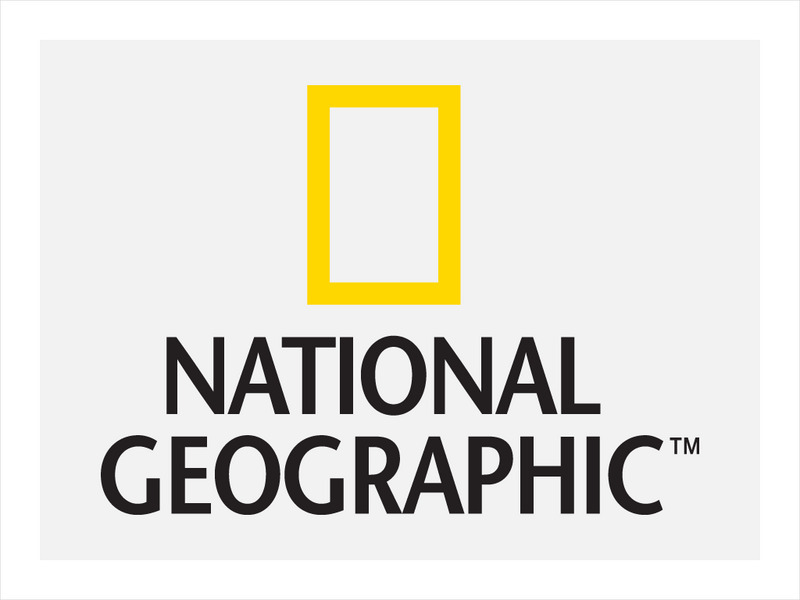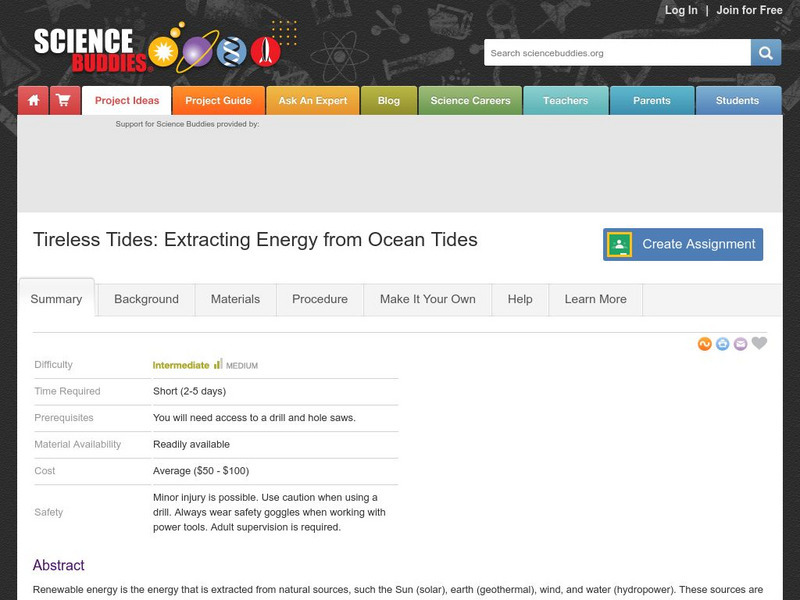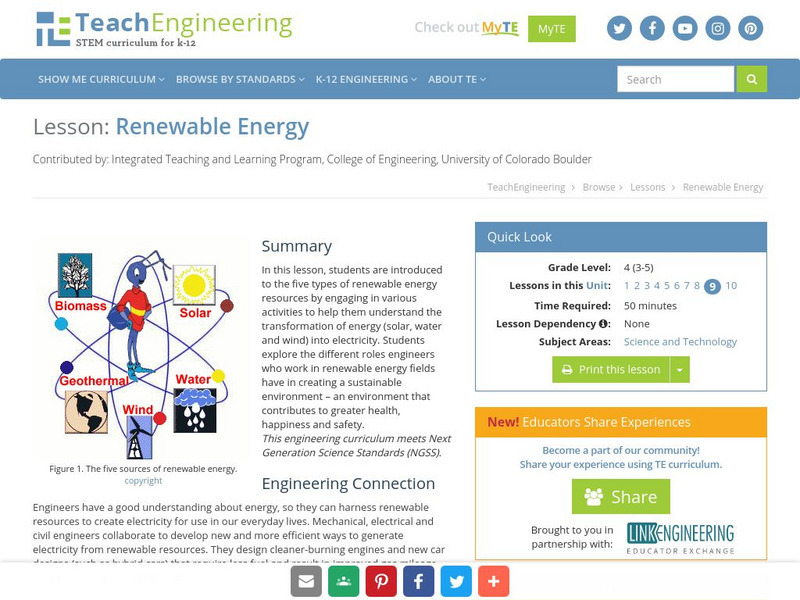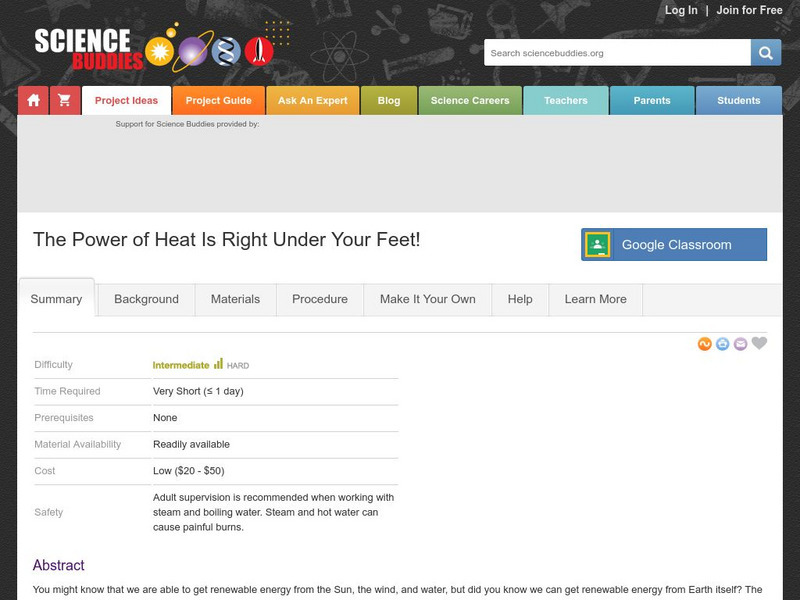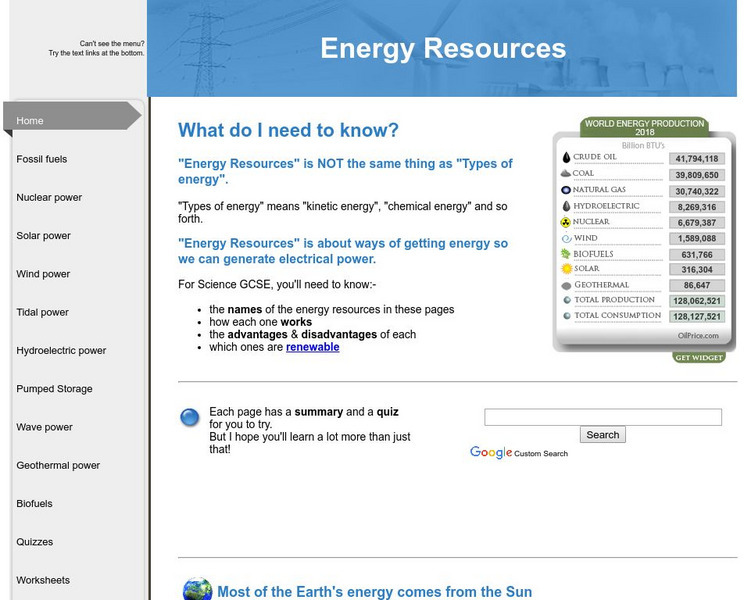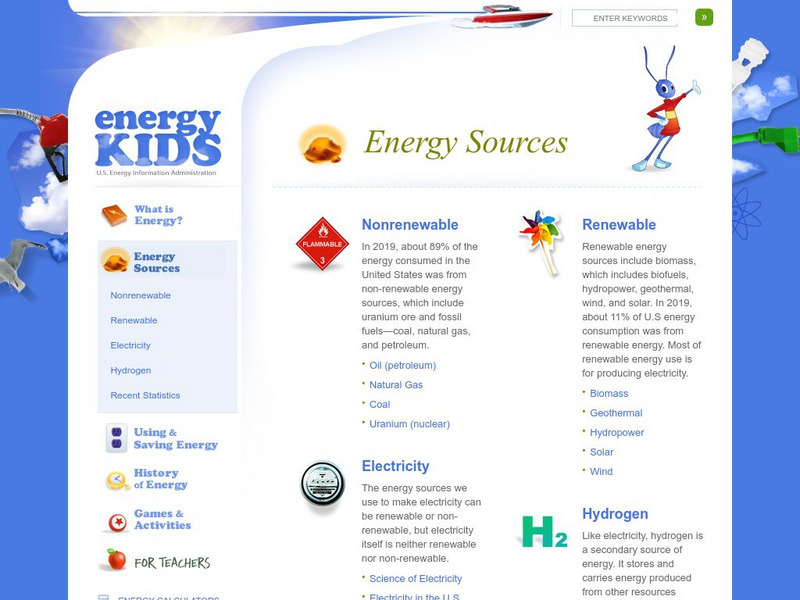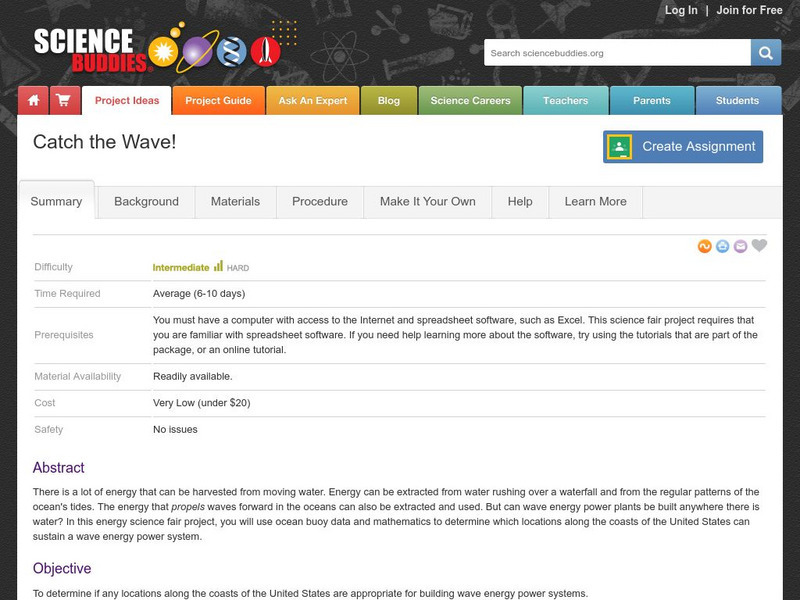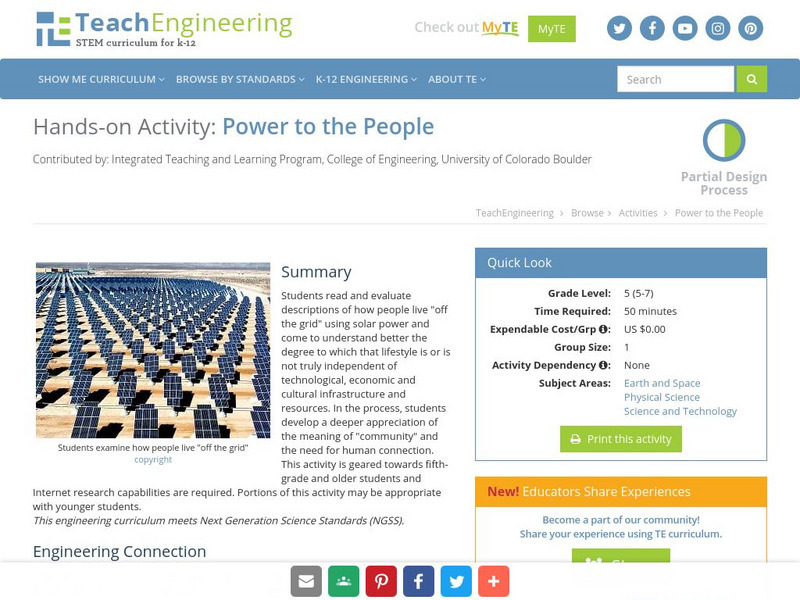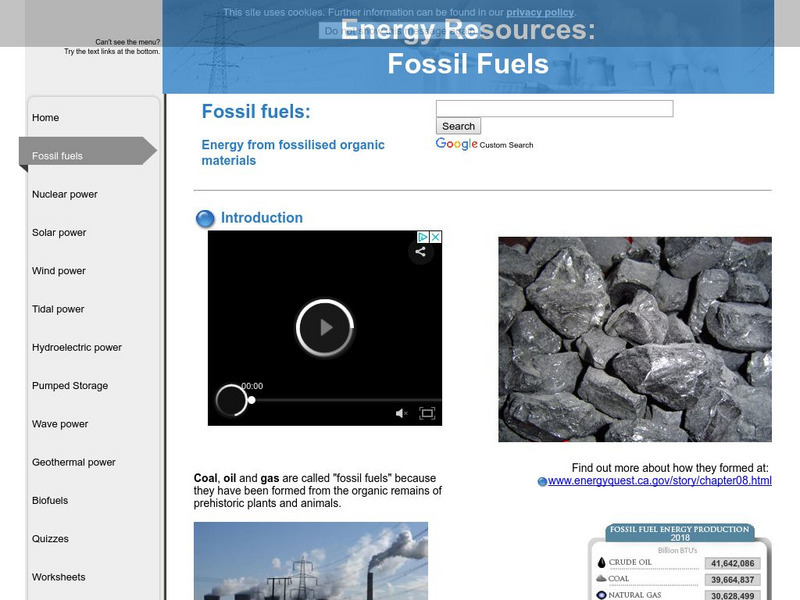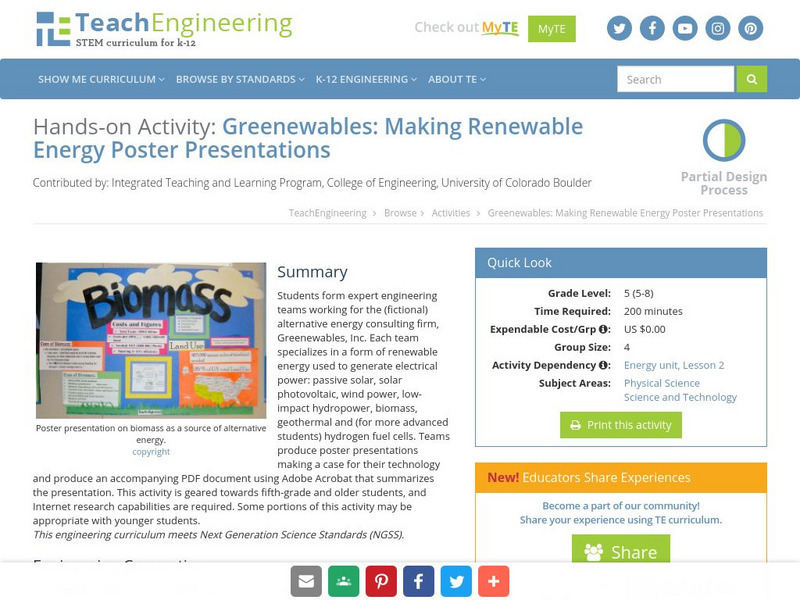National Geographic
National Geographic: Evaluating Other Energy Sources
A comprehensive lesson where students examine the different costs and benefits associated with renewable and nonrenewable sources of electricity. Includes a 22-question interactive module where they look at real-world data and images...
Science Buddies
Science Buddies: Project Ideas: Growing Green: How to Extract Energy From Grass
In this energy science fair project, the student will experiment with three types of grasses and determine which variety yields the highest amount of biomass. The Science Buddies project ideas are set up consistently beginning with an...
Science Buddies
Science Buddies: Tireless Tides: Extracting Energy From Ocean Tides
Renewable energy is the energy that is extracted from natural sources, such the Sun (solar), earth (geothermal), wind, and water (hydropower). These sources are renewable because they can be replenished by the same natural sources within...
Alabama Learning Exchange
Alex: Energy and Work Amusement Park Style
This is a lesson presenting energy and work. It covers: types of energy, forms of energy, work, law of conservation of energy, and renewable and nonrenewable energy sources. In the activities section, one will find links to Internet...
Georgia Department of Education
Ga Virtual Learning: Environmental Science: Mineral and Energy Resources
Students explore the topics of mineral extraction, renewable and nonrenewable resources, and hazardous wastes in this comprehensive, interactive module.
TeachEngineering
Teach Engineering: Renewable Energy
In this lesson, students are introduced to the types of renewable energy resources. They are involved in activities to help them understand the transformation of energy (solar, water and wind) into electricity. Students explore the...
Science Buddies
Science Buddies: The Power of Heat Is Right Under Your Feet!
You might know that we are able to get free energy from the Sun, the wind, and water, but we can also get free energy from Earth itself. This source of energy is called geothermal energy and it is all about taking advantage of the heat...
CK-12 Foundation
Ck 12: Earth Science: Renewable vs. Non Renewable Energy Resources Study Guide
[Free Registration/Login may be required to access all resource tools.] Summarizes the key points about renewable and nonrenewable resources. Includes a few questions to check for understanding.
US Department of Energy
U.s. Department of Energy: Water Power Program: Types of Hydropower Plants
Learn about the three types of hydroelectric power plants used to capture the energy from water at a hydropower dam site.
US Department of Energy
U.s. Department of Energy: Coal: Our Most Abundant Fuel
The U.S. has enough coal to last for the next 200-300 years. So why are we not using more of it? This article describes the different types or "ranks" of coal, the history, and the problems with burning coal for energy.
CK-12 Foundation
Ck 12: Life Science: 12.29 Renewable Resources
Learn how some renewable resources contribute to alternative energy sources.
Other
Energy Resources
Finding alternative energy sources is a challenge facing the leaders of today and tomorrow. Andy Darvill has created an impressive resource, summarizing various renewable and non-renewable energy resources.
Science4Fun
Science4 Fun: Solar Energy
What is solar energy? Learn about solar heating, solar electricity generation, and the advantages and disadvantages of solar power.
Ducksters
Ducksters: Environment for Kids: Renewable Energy
Kids learn about renewable energy and how it can help the environment. Teach students about solar, wind, biomass, and geothermal energy.
US Energy Information Administration
U.s. Eia Energy Kids: Energy Sources
Find out about energy resources, and what it means to be renewable and nonrenewable sources.
US Energy Information Administration
U.s. Eia Energy Kids: Renewable Energy: Wind
Mankind has used the wind as an energy source for thousands of years. Discover other ways the wind is used to make energy.
Science Buddies
Science Buddies: Catch the Wave!
In this energy science fair project, the student will use ocean buoy data to determine if any locations along the coasts of the United States are appropriate for building wave energy power systems.
TED Talks
Ted: Ted Ed: How Do Solar Panels Work?
The Earth intercepts a lot of solar power: 173,000 terawatts. That's 10,000 times more power than the planet's population uses. So is it possible that one day the world could be completely reliant on solar energy? Richard Komp examines...
Ducksters
Ducksters: Environment for Kids: Wave and Tidal Energy
Kids learn about wave and tidal energy and how this renewable power can help the environment. Teach students about this new technology.
TeachEngineering
Teach Engineering: Power to the People
Students read and evaluate descriptions of how people live "off the grid" using solar power and come to understand better the degree to which that lifestyle is or is not truly independent of technological, economic and cultural...
Other
Energy Resources: Fossil Fuels
Alternative forms of energy site showcases fossil fuels. Discover how it works, its' advantages and disadvantages as well as whether or not it's a renewable resource.
Discovery Education
Discovery Education: Grade 3 5 Module: Designed for Efficiency [Pdf]
For this 3-5 teaching module, young scholars conduct experiments, explore with online interactives, and watch videos that help them understand how vehicles work. Then, students demonstrate their understanding by designing energy...
TeachEngineering
Teach Engineering: Greenewables
Students form expert engineering teams working for the (fictional) alternative energy consulting firm, Greenewables, Inc. Each team specializes in a form of renewable energy used to generate electrical power: passive solar, solar...
Other popular searches
- Renewable Energy Resources
- Renewable Energy Sources
- Non Renewable Energy Sources
- Non Renewable Energy Sources
